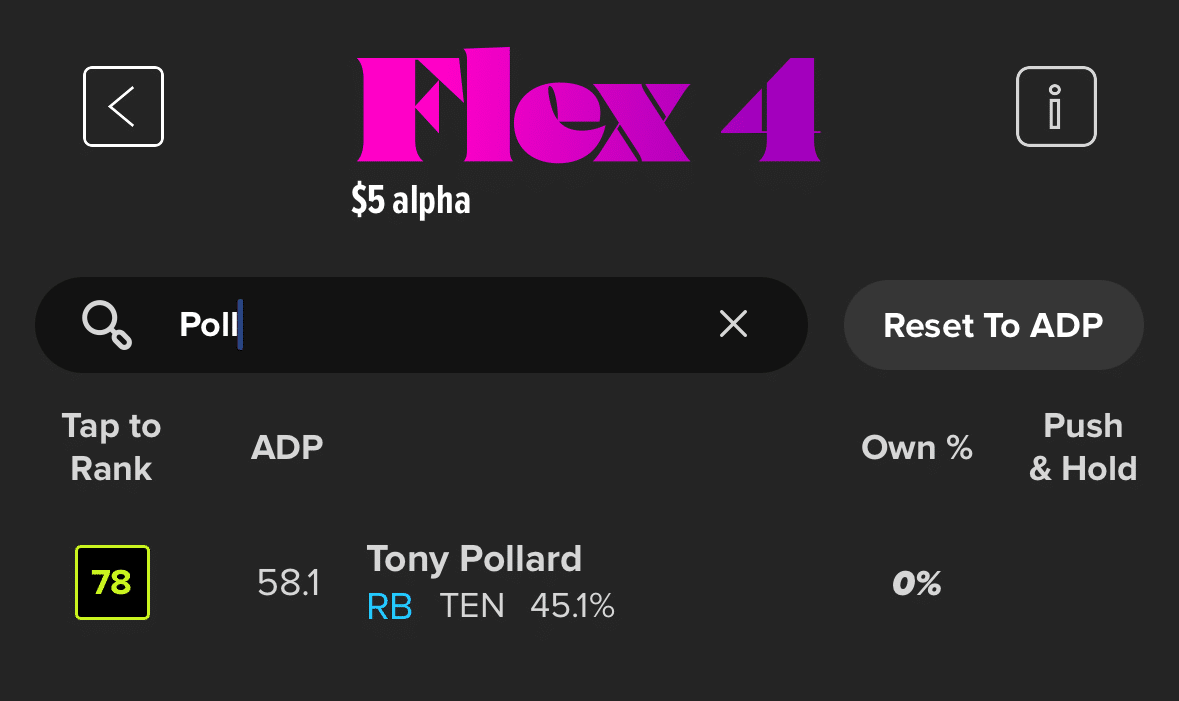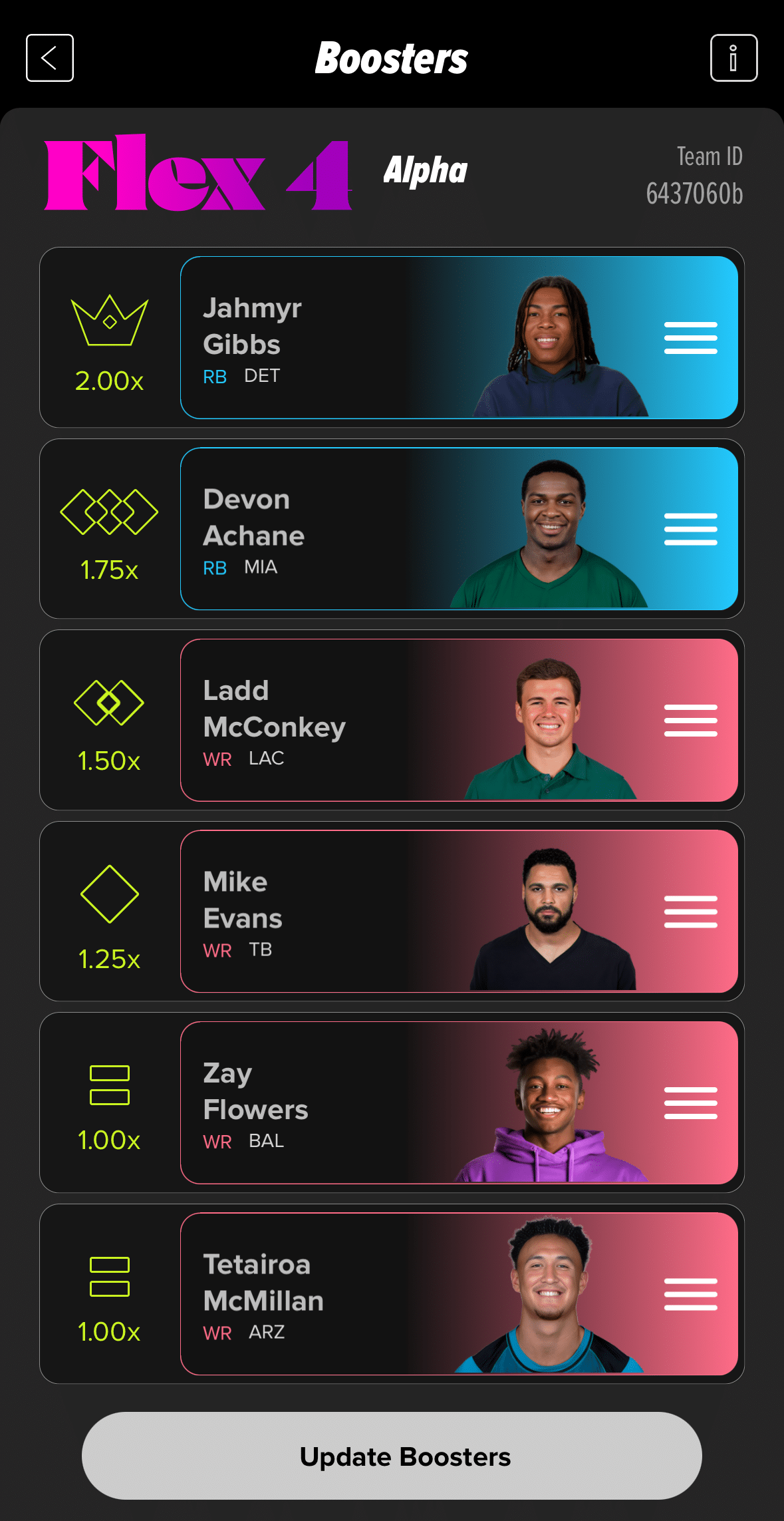Contest Basics
FastDraft’s Flex 4 tournament is a game changer in the Best Ball space. There are no positions! Hence the name Flex. The player pool consists of running backs, wide receivers, and tight ends however you can draft as many or little of each as you choose. This strategy guide will introduce the basics of the format while also diving deeper into the strategy to take first place. The 2025 contest has a rake free $50,000 prize pool ($10,000 to first!), with a $5 entry fee and a maximum of 10,000 entries (150 max per user). Each draft consists of 10 teams drafting six players each. This gives us a total of 60 players selected in each draft.
Use promo code: SPIKE in the FastDraft app to receive a 100% deposit bonus up to $50 on your initial deposit.
As this is Best Ball, the four highest-scoring players of your six are automatically selected for your starting lineup each week. The Flex 4 tournament is season long cumulative scoring weeks 1-17. FastDraft uses full PPR scoring. Pick clocks are 20 seconds, you are looking at a maximum of 20 minutes per draft in the Flex 4 tournament if everyone runs out the clock on the pick. Very unlikely as users are coming here for a fast draft! I imagine most drafts will take only around 10 minutes. For FastDraft’s rules and gameplay of the Flex 4 tournament, click here.
Strategy
Positional History
The next piece I write is going to analyze Spike Score across Flex players. My initial lean is TE’s beyond Bowers and McBride are close to undraftable. I am very curious to learn how the running backs and wide receivers compete with each other in full PPR scoring. You can look at this today in Spike Week Stats on Spikeweek.com.
Ownership
Ownership is going to be an important factor on how to build your teams, especially when you get to rounds 4-6. A player like Ja’Marr Chase will be drafted in every draft, leading to 1,000 Chase teams. Tony Pollard is currently only drafted 45% of the time, or 450 teams. Let’s move down a bit and think about Rashid Shaheed. He is currently only drafted 1.2% of the time and would only be on 12 teams. The contest is currently 17.2% full, so the team numbers here could change dramatically once Spike Weekers begin jumping into these contests. With only 60 players drafted in each draft, you can even get away with a chalky lineup through 5 rounds and take someone rarely drafted in the sixth round without sacrificing a ton of projection.


With the contest already over 17.2% full and set to close in September, it’s crucial to monitor two key things: players who become draftable due to their landing spot in the NFL Draft, and backup running backs who could move into starting roles because of injuries. Take Will Shipley, for example—he’s currently 0% rostered, but if Saquon Barkley were to go down, Shipley would be an absolute steal. His maximum exposure across the contest would be just 82.8%, and that number is shrinking every day.
Combinatorial Ownership
Combinatorial Ownership is going to give you massive leverage in this contest. It’s not just about how often a single player is drafted — it’s about how often specific combinations of players appear together on rosters. Since only 60 players are drafted in each room and there are so many possible team constructions, even common players can become part of incredibly unique builds when paired with less-drafted options. By being intentional about how your players overlap with others in the field, you can build teams that are both high-upside and hard to duplicate, increasing your chances of standing alone at the top when it matters most. Stay tuned for new views in DraftIQ to view this for FastDraft contests. I am going to spend some time this summer thinking about total product ownership in regards to this contest.
Stacking
Stacking is a massive discussion point of other best ball tournaments. I will not be going out of my way to do it in this contest format. If you remember Billy Jones’ article from last year analyzing single game correlation, there isn’t hardly any evidence to support correlation between a WR1 and the WR2, RB1, and TE1 on the same team in a single game. WR1 and WR2 are the strongest at a correlation coefficient of .345. The strength of the relationship is shown by its closeness to 1, or inversely, the closer to 0 the value, the greater the indication there is no correlation at all. By no means is this a single game tournament as it is cumulative weeks 1-17, however I anticipate the drafted player pool will be quite condensed and this is one lever most Best Ballers will have trouble not pulling. A few examples; I am probably avoiding Ja’marr Chase and Tee Higgins together unless Tee falls dramatically. I won’t be drafting two very expensive players from the same team together such as Saquon Barkley with AJ Brown.
Bye Weeks
Ideally, you want no more than 0 to 2 players on bye in any given week, with a strong preference for just 0 or 1. I’ll be actively managing for that, knowing injuries are inevitable and a little cushion goes a long way. The last thing I want is to enter a week unable to field a full starting lineup. Avoiding stacking from the same team can also naturally help spread out bye weeks.
Captain Boosters
Captain Boosters are four unique multipliers that you can choose to apply to any of the six players on your team. The four Captain Booster Positions are:
- 2.00 times the total fantasy points scored.
- 1.75 times the total fantasy points scored.
- 1.50 times the total fantasy points scored.
- 1.25 times the total fantasy points scored.

You get to determine who to apply the boosters to up until opening kickoff in September for each team. To update a booster, you simply click and drag a player to a different booster option. Once kickoff occurs they are locked in for the season. Here’s something that may easily be overlooked. If a user doesn’t update these manually, they are automatically applied based upon the players drafted in rounds 1-4. Having your first round player be 2x points makes a lot of sense, but is there that much of a difference between your third, fourth and fifth rounder. Placing your 1.5x or 1.25x on players routinely not going in the first four rounds is a way to give yourself a shot at the first place prize. I assume many drafters will not update their captain boosters ever so even minor tweaks will give you an advantage. If you did manage to have 3 bye players on bye because of whatever reason, I’d consider only putting a booster on 1, maybe 2 of them. There’s a lot to think through with boosters and this paragraph is more of a start of the conversation as opposed to fully fleshed out ideas.
Conclusion
I can’t wait to jump into the Flex 4 tournament and check out the other offerings on FastDraft. The new puzzle to solve truly excites me. Look for more content and tools tailored toward FastDraft this summer. If this article spurred any strategy ideas for you, come share in the FastDraft-NFL channel in the Spike Week Discord. There’s so much room for creativity in this format, and every small edge could be the difference between finishing in the top 100 or taking down the whole thing. The absence of positional requirements opens the door for truly unique builds, and that’s where the fun begins. Don’t be afraid to get weird — it’s often the contrarian paths that lead to the biggest rewards. Good luck and see you at the top of the leaderboard!
Bonus Nugget
You can actually go back and look at the leaderboard for last years contest and view how the winning lineups were constructed even if you didn’t play in it! I love that transparency.





